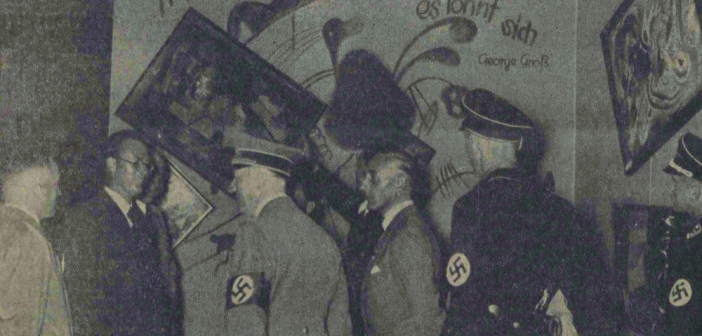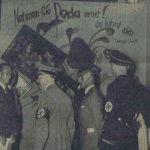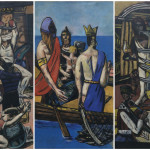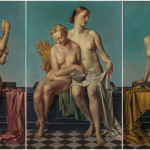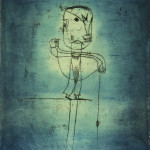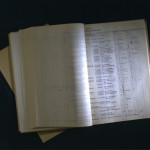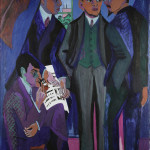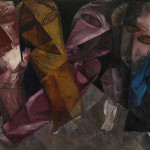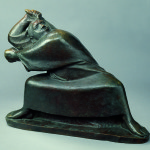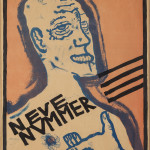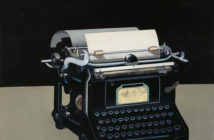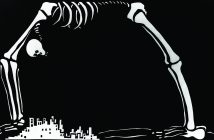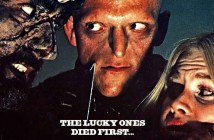The original Entartete Kunst, or "Degenerate Art" exhibition of 1937 was the product of the Säuberungskrieg, or "cleansing war" against modern art, which Hitler viewed as a deliberate attempt to "insult German feeling [and]destroy or confuse natural form." A failed artist himself, his pathological vitriol toward modern art, which he deemed incompetent and elite, comes as no surprise. Under their Fuhrer’s orders, Reich Minister of Propaganda Josef Goebbels and Hitler’s favorite painter Adolf Ziegler assembled an exhibition that would present this anti-ideal to the German public, revealing modern art’s "merciless… destruction against the last… elements of cultural disintegration."
 Adolf Ziegler (1892-1959)
Adolf Ziegler (1892-1959)The Four Elements: Fire (left wing), Earth and Water (center panel), Air (right wing), 1937
Oil on canvas
66 7/8 x 106 ¼ in. (170 x 270 cm)
Pinakothek der Moderne, Bayerische Staatsgemaeldesammlungen, Munich
Photo credit: bpk, Berlin/Art Resource, NY
The first part of the exhibition title, "Degenerate Art: The Attack on Modern Art in Nazi Germany," currently at the Neue Galerie in New York, is somewhat misleading in that it hints at a re-creation of the original exhibition. The 1937 Entartete Kunst was an intentional mess of modern works hung in dark, narrow rooms with derogatory slogans painted on the walls where viewers were invited to spit on the work. The Neue exhibition presents a sampling of "Degenerate" work alongside Nazi propaganda posters and the stiff, soulless art endorsed by Hitler: visual platitudes featuring muscular Aryans looking into the distance as if toward a future ideal earned through "blood and soil." A prime example, Hans Schmitz-Weidenbrück’s Workers, Soldiers and Peasants (painted in 1941 but nevertheless included here) depicts a forger, soldiers and a farmer defiantly confronting the viewer or staring to the side in preparation for battle. With a strong lean toward the Degenerates, the Neue show heavy-handedly yet effectively underscores its message of oppression and terror in a long hallway with a photograph of a Nazi rally covering the entire wall on one side and a group of camp prisoners on the other. This is not the first time a museum has attempted a loose version of this landmark exhibition (the last was at the Los Angeles County Museum of Art in 1991). Its subject serves as a blueprint revealing the far-reaching tentacles of Nazi rule into German culture. While polished, the show—through painting, sculpture, prints and documentary footage—provides a thorough overview of this historical chapter. It is haunting and heartbreaking.
One great irony of the Nazi war on modern art is that Goebbels was himself a great admirer of modernism, interpreting the discord and chaos conveyed through Expressionism as an embodiment of the forward-looking Germanic spirit. In 1933 he sent a fawning letter to Edvard Munch on the artist’s seventieth birthday calling him "the Greatest Painter of the Germanic World." When Hitler saw a group of watercolors by Emil Nolde hanging in Goebbels’ home, he flew into a rage and they were removed. Always loyal, Goebbels put personal taste aside to allow for the new Nazi ideal. His new task: to spin his once-beloved artists as madmen and head a commission to purge state collections and museums, confiscating 5,238 works within two weeks.
The Entartete Kunst exhibition featured 650 of these paintings, sculptures and prints. It opened in Munich and subsequently criss-crossed Germany and Austria for three years, with much of the work lost or destroyed along the way. The word Entartete is a biological term meaning degenerate or decadent and refers to a rogue cell that causes deformity. This coincided with Hitler’s view of modern art: deranged, deformed and "unfinished," the antithesis of the Teutonic spirit. Of the 112 artists featured, only six were actually Jewish.
 Paul Klee (1879-1940)
Paul Klee (1879-1940)The Angler, 1921
Watercolor, transfer drawing and ink on paper
18 7/8 x 12 3/8 in. (50.5 x 31.8 cm)
The Museum of Modern Art, New York. John S. Newberry Collection
Digital Image © 2014 The Museum of Modern Art/Licensed by SCALA/
Art Resource, NY
© 2014 Artists Rights Society (ARS), New York
The focus was on German artists viewed as traitors to the state, including members of the Expressionist movements Die Bruke, the New Objectivity, The Blue Rider, several independent German artists, as well as a few foreigners including Chagall, Mondrian and Picasso. The sea change within the artistic zeitgeist was swift and brutal. Artists like Nolde (who continued to insist his work was German in spirit and even courted the Nazis) worked in secrecy (hence the popular switch to works on paper during this time to avoid tell-tale turpentine fumes). Others, like Max Beckmann and George Grosz, immigrated to America. Ernst Ludwig Kirchner retired to the Swiss Alps where he continued to work until his suicide in 1938. Lesser-known artists like Elfriede Lohse-Wächtler and Otto Freundlich perished in the camps. No one was safe—even Hitler’s beloved Ziegler fell out of favor for joining in secret police negotiations with the Allies. In 1943 he was sent to Dachau.
In contrast to this vipers’ nest of depravity, the Große Deutsche Kunstausstellung ("The Great German Art Exhibition") was held directly across the street to coincide with the Degenerate exhibition. Here visitors could see work that defined the Reich’s "racially pure" ideals. The quality of the work was so poor that even Hitler himself was embarrassed and, as recorded by Goebbels, "wild with rage." It hardly mattered: everyone knew the focus was on the Degenerates. The deliberately savage presentation of Entartete Kunst was propaganda used to make the work across the street look good. But human nature is such that most people prefer scandal over the mundane, and over a million people attended the Degenerate Art exhibition in its first six weeks. By the end of their concomitant four month runs, Entartete Kunst drew twice the number of visitors as the Great German Art Exhibition, with ravenous, curious, or even quietly sympathetic Germans queuing up outside each day.
The rooms in the 1937 exhibition were grouped thematically (e.g. works considered demeaning of religion; works by Jews in particular; works deemed insulting to German women, soldiers and farmers). The Neue show opts for themes like "The Fate of the Artists" (dedicated to artists who lost their lives to the Regime) or "Art Owned by Hitler." Absent are the slogans of the original show (e.g. "Revelation of the Jewish racial soul" and "Nature as seen by sick minds") or the labels grossly exaggerating how much money museums had spent to acquire the artwork as proof that the work was a conspiracy by anti-German "Jewish-Bolshevists." There is no attempt on the part of the Neue Galerie to reconstruct the original show as it was presented.
Is that bad? No, because such an endeavor would be impossible. While a handful of works that appeared in the original show are featured, most of the works are first-rate examples of German Expressionism, culled from the museum’s collection. So we have pieces by artists who had work in the original exhibition, just not the pieces shown here. Still, their impact provides a sobering reminder of the disdain that the most innovative contemporary art— German, Degenerate or otherwise—was met with in the early to mid twentieth century within and outside the Nazi regime.
 Max Beckmann (1884-1950)
Max Beckmann (1884-1950)Departure, Frankfurt 1932, Berlin 1933-35
Oil on canvas
84 ¾ x 39 ¼ in. (215.3 x 99.7 cm)
The Museum of Modern Art, New York. Given anonymously (by exchange)
Digital Image © 2014 The Museum of Modern Art/Licensed by SCALA/ Art Resource, NY
© 2014 Artists Rights Society (ARS), New York/VG Bild-Kunst, Bonn
One of the most touted features of the exhibition juxtaposes Max Beckmann’s triptych Departure (1932-1935) with Adolf Ziegler’s triptych The Four Elements (1937). The former features Beckmann’s arcane yet ominously familiar personal iconography set within the cramped confines of the canvases. The side panels use a dark pallet to depict nightmare scenes of torture, bondage and impending rape, complete with bound and gagged men and women on the left (one with her hands chopped off to expose bloody stumps) amidst a still life of oversized fruit made more disturbing for its banality. The right panel shows a woman and man bound together (the man upside down,) while a drummer moves gloomily across the bottom as if walking out of the panel, beating a funereal dirge. The central panel features Beckmann’s recurrent figure of a king and his boatmen (one holding a child) shoving off on a cerulean blue ocean with oars and fishing nets, blithely escaping the terrors that flank them. The latter piece by Zieger is an unremarkable assembly of asexual female nudes representing the title’s subjects. Neither of these works appeared in the 1937 exhibitions: the former was still at large, while the latter hung over Hitler’s fireplace. Still, it is a perfect juxtaposition of the dynamism of Expressionism with the awkward neo-classicism of the Nazi ideal. These examples prove educational and a visual treat, most of the time. The Nazi art (aside from the admittedly innovative graphics of propaganda posters,) makes for painfully dull viewing. Excepting the two triptychs, the Nazi paintings are grouped together on one wall.
The historical moment of the original exhibition’s inception no doubt accounts for the massive appeal of the current show. It is the first blockbuster the Neue has mounted (as evinced by the extension of the closing date, abundant press, and lines that wend daily around the block). While the Neue has had better shows (e.g. the tour de force "Otto Dix" or the focused "Oskar Kokoshka: Early Portraits from Vienna and Berlin",) nothing of this breadth has been assembled for over two decades. Despite the show’s (necessary) lack of fidelity to the original, it remains a rare opportunity to see both sublime work and historical curiosities.
- Adolf Hitler and other Nazi officials (Hoffmann, Willrich, Hansen, and Ziegler) standing by the Dada wall at the “Entartete Kunst” (Degenerate Art) exhibition, July 16, 1937. Paintings by Vasily Kandinsky, Paul Klee, and Kurt Schwitters have been deliberately hung askew and are accompanied by a slogan penned by George Grosz. This photo was published in the Nationalist Observer, South German (Süddeutsche) issue, No. 199, July 18, 1937. Staatsbibliothek zu Berlin Stiftung Preussischer Kulturbesitz, Berlin, Germany. bpk, Berlin, Art Resource, NY
- Max Beckmann (1884-1950) Departure, Frankfurt 1932, Berlin 1933-35 Oil on canvas 84 ¾ x 39 ¼ in. (215.3 x 99.7 cm) The Museum of Modern Art, New York. Given anonymously (by exchange) Digital Image © 2014 The Museum of Modern Art/Licensed by SCALA/ Art Resource, NY © 2014 Artists Rights Society (ARS), New York/VG Bild-Kunst, Bonn
- Adolf Ziegler (1892-1959) The Four Elements: Fire (left wing), Earth and Water (center panel), Air (right wing), 1937 Oil on canvas 66 7/8 x 106 ¼ in. (170 x 270 cm) Pinakothek der Moderne, Bayerische Staatsgemaeldesammlungen, Munich Photo credit: bpk, Berlin/Art Resource, NY
- Paul Klee (1879-1940) The Angler, 1921 Watercolor, transfer drawing and ink on paper 18 7/8 x 12 3/8 in. (50.5 x 31.8 cm) The Museum of Modern Art, New York. John S. Newberry Collection Digital Image © 2014 The Museum of Modern Art/Licensed by SCALA/ Art Resource, NY © 2014 Artists Rights Society (ARS), New York
- Ernst Ludwig Kirchner (1880-1938) A Group of Artists (The Painters of the Brücke), 1925-26 Oil on canvas 66 1/8 x 49 5/8 in. (168 x 126 cm) Museum Ludwig, Cologne Photo: © Rheinisches Bildarchiv Cologne
- Lasar Segall (1891-1957) Eternal Wanderers, 1919 Oil on canvas 54 3/8 x 72 ½ in. (138 x 184 cm) Lasar Segall Museum, IBRAM/Ministry of Culture Photo: Jorge Bastos
- Ernst Barlach (1870-1937) The Berserker, 1910 Bronze 21 ½ x 28 7/8 x 10 3/8 in. (54.5 x 73.4 x 26.4 cm) © Ernst Barlach Haus — Stiftung Hermann F. Reemtsma, Hamburg Photo: H.-P. Cordes
- Oskar Kokoschka (1886-1980) Poster with Self-Portrait for Der Sturm magazine, 1910 Colored lithograph 26 3/8 x 17 5/8 in. (67 x 44.7 cm) © Neue Galerie New York. Gift of Leonard A. Lauder © 2014 Fondation Oskar Kokoschka/Artists Rights Society (ARS), New York/ ProLitteris, Zürich
Degenerate Art: The Attack on Modern Art in Nazi Germany, 1937 runs until September 1, 2014 at New York City's Neue Galerie.
www.neuegalerie.org

